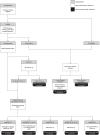Developing a systems-focused tool for modeling lung cancer screening resource needs
- PMID: 39237997
- PMCID: PMC11378520
- DOI: 10.1186/s12962-024-00573-w
Developing a systems-focused tool for modeling lung cancer screening resource needs
Abstract
Background: Early detection through screening dramatically improves lung cancer survival rates, including among war Veterans, who are at heightened risk. The effectiveness of low dose computed tomography scans in lung cancer screening (LCS) prompted the Veteran's Affairs Lung Precision Oncology Program (VA LPOP) to increase screening rates. We aimed to develop an adaptive population health tool to determine adequate resource allocation for the program, with a specific focus on primary care providers, nurse navigators, and radiologists.
Methods: We developed a tool using C + + that uses inputs that represents the process of the VA LCS program in Ann Arbor, Michigan to calculate FTEs of human resource needs to screen a given population. Further, we performed a sensitivity analysis to understand how resource needs are impacted by changes in population, screening eligibility, and time allocated for the nurse navigators' tasks.
Results: Using estimates from the VA LCS Program as demonstrative inputs, we determined that the greatest number of full-time equivalents required were for radiologists, followed by nurse navigators and then primary care providers, for a target population of 75,000. An increase in the population resulted in a linear increase of resource needs, with radiologists experiencing the greatest rate of increase, followed by nurse navigators and primary care providers. These resource requirements changed with primary care providers, nurse navigators and radiologists demonstrating the greatest increase when 1-20, 20-40 and > 40% of Veterans accepted to be screened respectively. Finally, when increasing the time allocated to check eligibility by the nurse navigator from zero to three minutes, there was a linear increase in the full-time equivalents required for the nurse navigator.
Conclusion: Variation of resource utilization demonstrated by our user facing tool emphasizes the importance of tailored strategies to accommodate specific population demographics and downstream work. We will continue to refine this tool by incorporating additional variability in system parameters, resource requirements following an abnormal test result, and resource distribution over time to reach steady state. While our tool is designed for a specific program in one center, it has wider applicability to other cancer screening programs.
Keywords: Interventions; Lung cancer screening program; Resource allocations; Screening; Veterans affairs.
© 2024. The Author(s).
Conflict of interest statement
The authors declare no competing interests.
Figures



References
-
- Department of Veterans Affairs. Diffusion Marketplace. 2022 [cited 2024 Mar 4]. https://marketplace.va.gov/innovations/centralized-lung-cancer-screening
-
- Denise R, Aberle MD, U, of California at Los Angeles, Amanda LA, Adams M, University MPH, Providence RI, Christine D, Berg MD, Division of Cancer Prevention NCI, Bethesda MD, William C, Black MD, Dartmouth–Hitchcock Medical Center, Lebanon, Jonathan NH, Clapp D, I BS, Management Services, Rockville MD, Richard M, Fagerstrom PD, Division of Cancer Prevention, National Cancer Institute B, Ilana MD, Gareen F et al. Ph.D., ACRIN Biostatistics Center, Brown University, Providence, RI; Constantine Gatsonis, Ph.D. A,. Reduced Lung-Cancer Mortality with Low-Dose Computed Tomographic Screening. N Engl J Med. 2015;352:687–96.
-
- Franchio C, VA NOPM. (. Screening and diagnosing lung cancer early. VA News. 2023.
Grants and funding
- VA 150CU000182: PI Ramnath/Lung Precision Oncology Program
- VA 150CU000182: PI Ramnath/Lung Precision Oncology Program
- VA 150CU000182: PI Ramnath/Lung Precision Oncology Program
- VA 150CU000182: PI Ramnath/Lung Precision Oncology Program
- VA 150CU000182: PI Ramnath/Lung Precision Oncology Program
- VA 150CU000182: PI Ramnath/Lung Precision Oncology Program
- VA 150CU000182: PI Ramnath/Lung Precision Oncology Program
- VA 150CU000182: PI Ramnath/Lung Precision Oncology Program
- VA 150CU000182: PI Ramnath/Lung Precision Oncology Program
- VA 150CU000182: PI Ramnath/Lung Precision Oncology Program
- VA 150CU000182: PI Ramnath/Lung Precision Oncology Program
- VA 150CU000182: PI Ramnath/Lung Precision Oncology Program
- VA 150CU000182: PI Ramnath/Lung Precision Oncology Program
- VA 150CU000182: PI Ramnath/Lung Precision Oncology Program
LinkOut - more resources
Full Text Sources

